语外研版选修八Module 1 Deep South Reading The Antarctica 课件(19张ppt)
文档属性
| 名称 | 语外研版选修八Module 1 Deep South Reading The Antarctica 课件(19张ppt) |
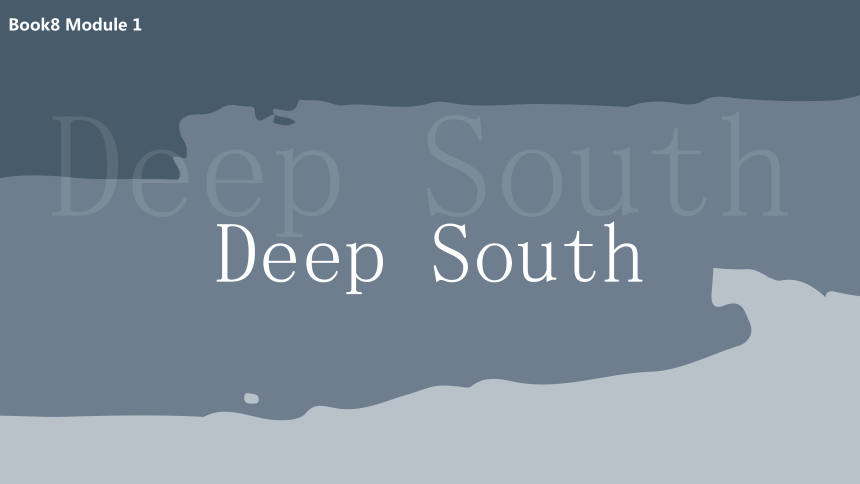
|
|
| 格式 | pptx | ||
| 文件大小 | 1.0MB | ||
| 资源类型 | 教案 | ||
| 版本资源 | 外研版 | ||
| 科目 | 英语 | ||
| 更新时间 | 2023-02-08 14:38:29 | ||
图片预览

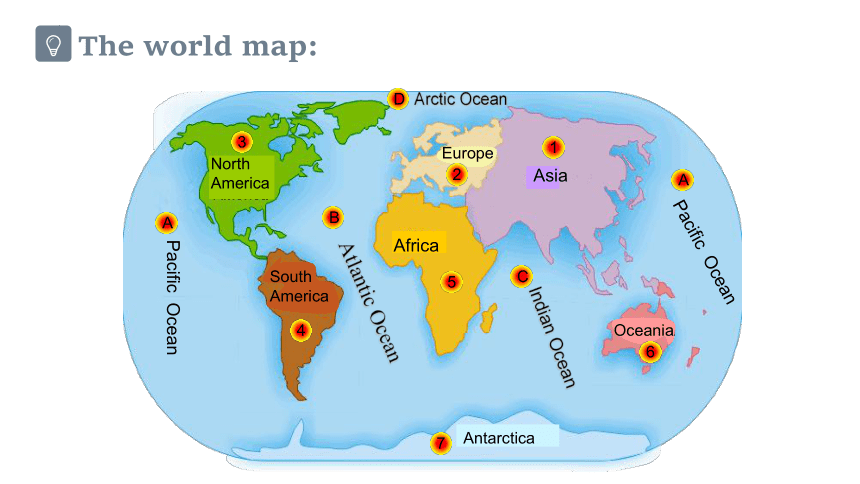
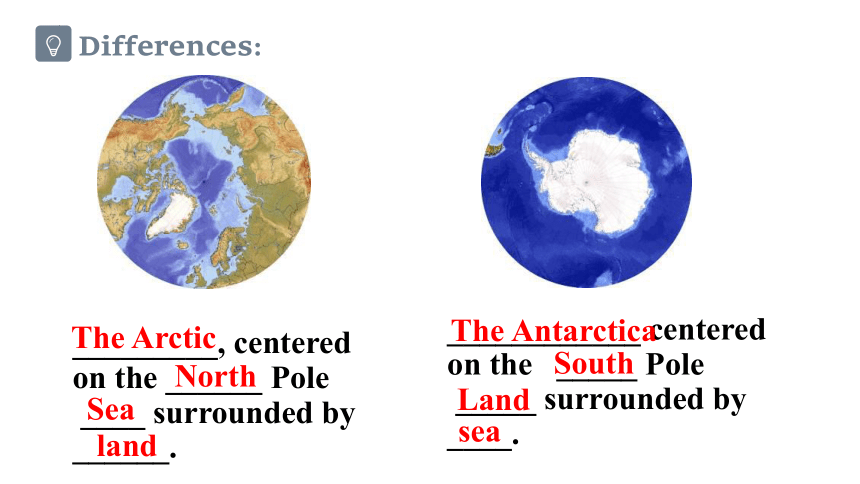
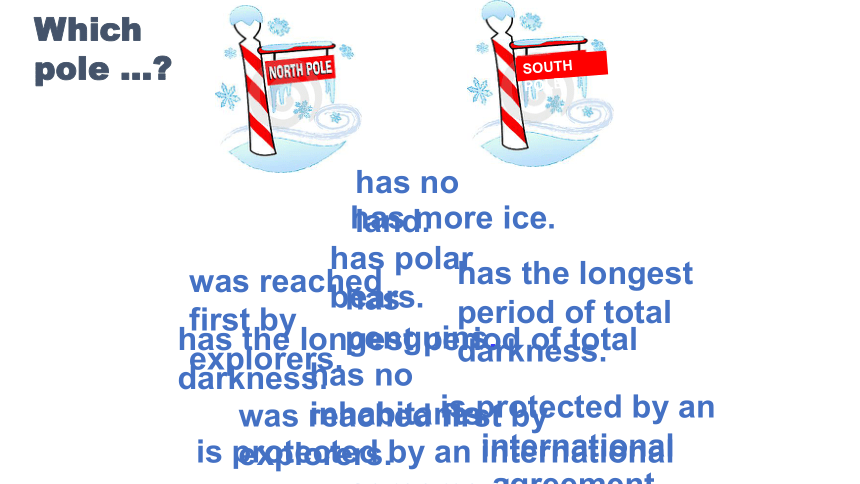
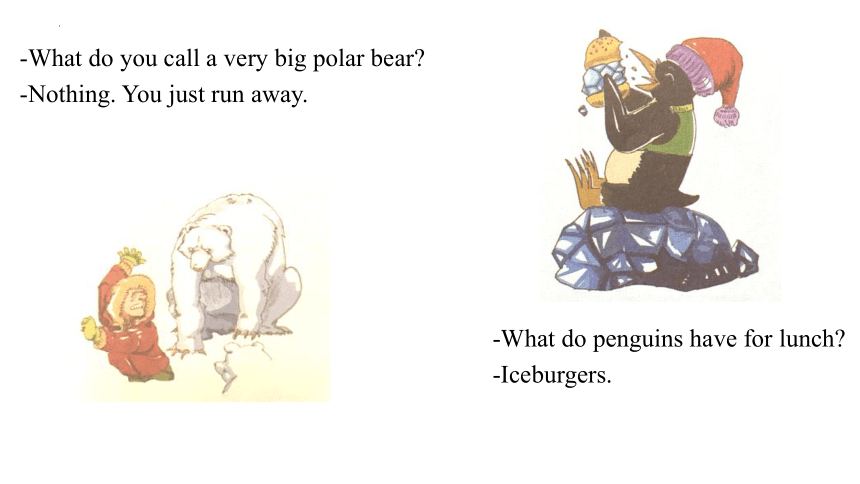
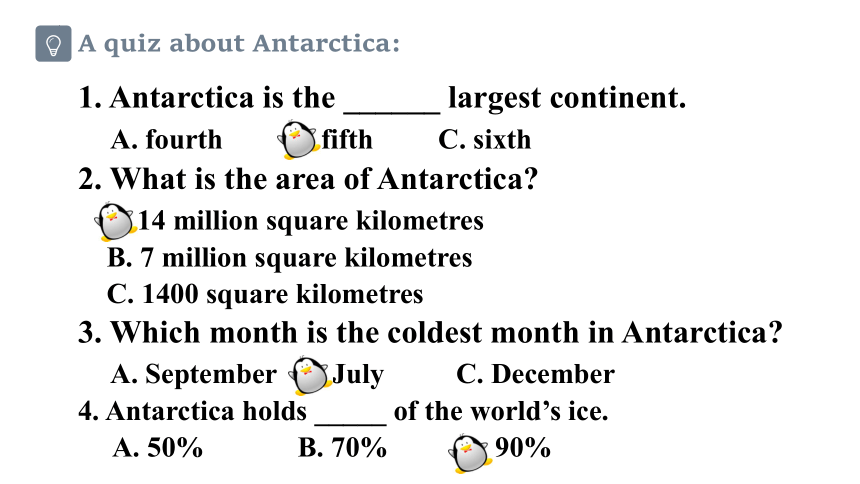
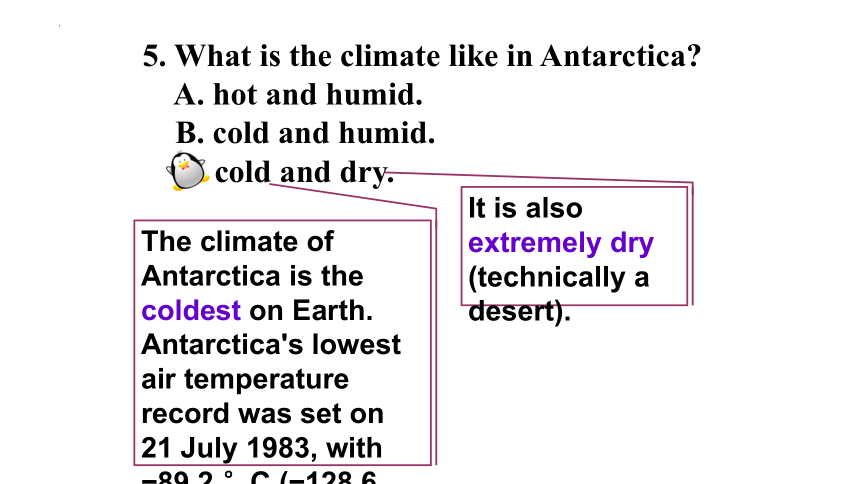
文档简介
(共19张PPT)
Deep South
Book8 Module 1
Deep South
Atlantic Ocean
Pacific Ocean
Pacific Ocean
Indian Ocean
Asia
North
America
Europe
Africa
South
America
Oceania
Antarctica
Arctic Ocean
1
2
3
4
5
6
7
A
A
B
C
D
The world map:
_________, centered on the ______ Pole
____ surrounded by ______.
____________ centered on the _____ Pole
_____ surrounded by ____.
The Arctic
Sea
The Antarctica
North
land
South
Land
sea
Differences:
SOUTH POLE
has no land.
has more ice.
has polar bears.
has penguins.
has the longest period of total darkness.
has no inhabitants.
was reached first by explorers.
is protected by an international agreement.
has the longest period of total darkness.
was reached first by explorers.
is protected by an international agreement.
Which pole …
What do you call a very big polar bear
Nothing. You just run away.
What do penguins have for lunch
Iceburgers.
A quiz about Antarctica:
Antarctica is the ______ largest continent.
A. fourth B. fifth C. sixth
2. What is the area of Antarctica
A. 14 million square kilometres
B. 7 million square kilometres
C. 1400 square kilometres
3. Which month is the coldest month in Antarctica
A. September B. July C. December
4. Antarctica holds _____ of the world’s ice.
A. 50% B. 70% C. 90%
5. What is the climate like in Antarctica
A. hot and humid.
B. cold and humid.
C. cold and dry.
The climate of Antarctica is the coldest on Earth. Antarctica's lowest air temperature record was set on 21 July 1983, with 89.2 °C ( 128.6 °F) at Vostok Station.
It is also extremely dry (technically a desert).
A.
C.
B.
D.
6. Which animal doesn’t live in Antarctica
seal
polar bear
penguins
whale
Read the passage on P2-3 and get more information about Antarctica.
Read and choose a heading for each paragraph:
A great place for researchers
Plants and animals
The Antarctica Treaty
The discovery of Antarctica
The land
Para. 1
Para. 2
Para. 3
Para. 4
Para. 5
Antarctica: the last continent
Para 1: Brief introduction of Antarctica
The land
Size: ________ square kilometers; the _______ largest continent in the world
Location: around the _______________
Climate: the ______ and______ on Earth: annual rainfall _______
strong ______
Other geographical features:
1. Volcanoes: ___________
2. 90% of_____________, 70% in____________, 98% is covered in_________
3. The _______________ range
14 million
fifth
South Pole
coldest
driest
the world’s ice
a frozen state
the ice cap
Trans-Antarctica
close to zero
inhospitable
not active
winds
Para 2:
Plants and animals
Animals:
Plants:
Penguins, flying birds, seals, and whales
Why
Because they have adapted to its extreme conditions.
Only two types of flowering plants; no trees; mosses, algae and lichen.
Why
The long Antarctic winter night
The extreme cold
Lack of rainfall
Is there anything else valuable to explore in Antarctica
Para 3:
A great place for researchers
What are the objects that contribute to the research
· Ice
· Gases and minerals
· Rocks
becomes a window on the past and can give researchers lots of useful information.
How
can tell us a lot about what the climate was like in the past ages.
may contain evidence of extraterrestrial life.
How many stations have Chinese scientists established in Antarctica
Para 4:
The discovery of Antarctica
More than 2,000 years ago
In the 15th century
The late 18th
In 1895
On 11th Dec., 1911
Greek geographers believed there was a large land mass in the south.
Europeans discovered the continent of America, beginning the age of exploration.
British explorer, James Cook, cross the Antarctic Circle, never seeing the land.
A Norweigian became the first man to set foot on the Antarctic mainland
Roald finally reached the pole.
Since Antarctica is so important, what should we do to protect it
Para 5:
The Antarctica Treaty
Today
Aims
In 1961
12 countries signed the treaty.
Countries representing 80% of the world’s population have signed the treaty.
1. To prevent the commercial and military use of the continent
2. To keep it free from nuclear tests and radioactive waste
3. To promote international scientific projects
4. To end arguments about who owns the land
Antarctica: the Last Continent
What does the title mean
Why should people protect Antarctica
Antarctica is the last and largest unspoiled wilderness area on Earth.
Antarctica belongs to no one and everyone.
Antarctica is a continent for science, as it is so unspoiled that it acts as a laboratory for the rest of the world where changes can be measured in isolation from the effects of man.
How can people protect it
Say No to mining, toxic and noxious chemicals and some wastes.
Establish specially protected areas.
Commercial fisheries in the Southern Ocean are controlled by the CCAMLR - Convention on the Conservation of Antarctic Marine Living Resources (南极海洋生物资源养护委员会).
THANKS
THANKS
Deep South
Book8 Module 1
Deep South
Atlantic Ocean
Pacific Ocean
Pacific Ocean
Indian Ocean
Asia
North
America
Europe
Africa
South
America
Oceania
Antarctica
Arctic Ocean
1
2
3
4
5
6
7
A
A
B
C
D
The world map:
_________, centered on the ______ Pole
____ surrounded by ______.
____________ centered on the _____ Pole
_____ surrounded by ____.
The Arctic
Sea
The Antarctica
North
land
South
Land
sea
Differences:
SOUTH POLE
has no land.
has more ice.
has polar bears.
has penguins.
has the longest period of total darkness.
has no inhabitants.
was reached first by explorers.
is protected by an international agreement.
has the longest period of total darkness.
was reached first by explorers.
is protected by an international agreement.
Which pole …
What do you call a very big polar bear
Nothing. You just run away.
What do penguins have for lunch
Iceburgers.
A quiz about Antarctica:
Antarctica is the ______ largest continent.
A. fourth B. fifth C. sixth
2. What is the area of Antarctica
A. 14 million square kilometres
B. 7 million square kilometres
C. 1400 square kilometres
3. Which month is the coldest month in Antarctica
A. September B. July C. December
4. Antarctica holds _____ of the world’s ice.
A. 50% B. 70% C. 90%
5. What is the climate like in Antarctica
A. hot and humid.
B. cold and humid.
C. cold and dry.
The climate of Antarctica is the coldest on Earth. Antarctica's lowest air temperature record was set on 21 July 1983, with 89.2 °C ( 128.6 °F) at Vostok Station.
It is also extremely dry (technically a desert).
A.
C.
B.
D.
6. Which animal doesn’t live in Antarctica
seal
polar bear
penguins
whale
Read the passage on P2-3 and get more information about Antarctica.
Read and choose a heading for each paragraph:
A great place for researchers
Plants and animals
The Antarctica Treaty
The discovery of Antarctica
The land
Para. 1
Para. 2
Para. 3
Para. 4
Para. 5
Antarctica: the last continent
Para 1: Brief introduction of Antarctica
The land
Size: ________ square kilometers; the _______ largest continent in the world
Location: around the _______________
Climate: the ______ and______ on Earth: annual rainfall _______
strong ______
Other geographical features:
1. Volcanoes: ___________
2. 90% of_____________, 70% in____________, 98% is covered in_________
3. The _______________ range
14 million
fifth
South Pole
coldest
driest
the world’s ice
a frozen state
the ice cap
Trans-Antarctica
close to zero
inhospitable
not active
winds
Para 2:
Plants and animals
Animals:
Plants:
Penguins, flying birds, seals, and whales
Why
Because they have adapted to its extreme conditions.
Only two types of flowering plants; no trees; mosses, algae and lichen.
Why
The long Antarctic winter night
The extreme cold
Lack of rainfall
Is there anything else valuable to explore in Antarctica
Para 3:
A great place for researchers
What are the objects that contribute to the research
· Ice
· Gases and minerals
· Rocks
becomes a window on the past and can give researchers lots of useful information.
How
can tell us a lot about what the climate was like in the past ages.
may contain evidence of extraterrestrial life.
How many stations have Chinese scientists established in Antarctica
Para 4:
The discovery of Antarctica
More than 2,000 years ago
In the 15th century
The late 18th
In 1895
On 11th Dec., 1911
Greek geographers believed there was a large land mass in the south.
Europeans discovered the continent of America, beginning the age of exploration.
British explorer, James Cook, cross the Antarctic Circle, never seeing the land.
A Norweigian became the first man to set foot on the Antarctic mainland
Roald finally reached the pole.
Since Antarctica is so important, what should we do to protect it
Para 5:
The Antarctica Treaty
Today
Aims
In 1961
12 countries signed the treaty.
Countries representing 80% of the world’s population have signed the treaty.
1. To prevent the commercial and military use of the continent
2. To keep it free from nuclear tests and radioactive waste
3. To promote international scientific projects
4. To end arguments about who owns the land
Antarctica: the Last Continent
What does the title mean
Why should people protect Antarctica
Antarctica is the last and largest unspoiled wilderness area on Earth.
Antarctica belongs to no one and everyone.
Antarctica is a continent for science, as it is so unspoiled that it acts as a laboratory for the rest of the world where changes can be measured in isolation from the effects of man.
How can people protect it
Say No to mining, toxic and noxious chemicals and some wastes.
Establish specially protected areas.
Commercial fisheries in the Southern Ocean are controlled by the CCAMLR - Convention on the Conservation of Antarctic Marine Living Resources (南极海洋生物资源养护委员会).
THANKS
THANKS
